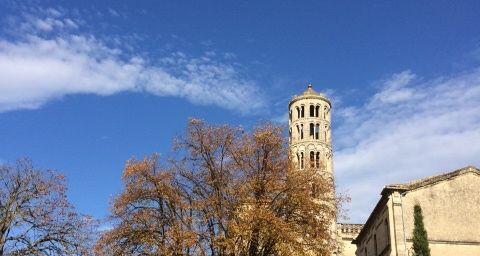Seeing the year through in the Midi
Our village, like many in southern France, has a semi-permanent population; one of the first questions asked on being introduced is whether or not we are here all year round. A fairly cosmopolitan atmosphere is enjoyed here, particularly throughout the summer months, evident at the annual 14th July celebrations opposite the clock tower, where Belgians, Americans, Swedes, Swiss, amongst others, raise a glass to la belle France.
With its climate, lifestyle and cuisine, France continues to exert a magnetic attraction for those wanting a foothold in the sun, if only for part of the year. Rating high in the ranking of second-homers, it is seen as a place to spend warm, leisurely summer days, passing the time on sun-dappled restaurant terraces and strolling around picturesque markets.
For those of us who have chosen to make our homes here, however, the perspective is altered slightly: visits to the dentist or tax office, arranging a car service or shopping for a new vacuum cleaner are likely to take precedence over a scenic drive out to a local olive oil mill. But if something is lost, something is also gained: the pleasures of being here out of season, when the second-homers return after their six month stay, are many.
Although the days up until around Christmas can be warm enough to lunch outside, the evenings in late October see an incense-like drift of smoke over the village as woods such as apple, plum and cherry, as well as thick logs of oak, are piled into fireplaces. As the evenings grow darker, the neighbours begin their rounds of apéro: invitations are offered to take aperitifs for an hour from seven o’clock, when tables groan with home-made patés and savoury cakes and pastries, to be enjoyed with a glass, maybe two, of local wine or the inevitable pastis. Occasionally, a dangerous home-made concoction is offered. Conversation ranges from village politics and the hunt for truffles – that ‘black gold’ unearthed in places jealously guarded – to, inevitably, la chasse, the major preoccupation during the winter months. At eight o’clock it’s not unusual to leave, staggering under the weight of a haunch or leg of a creature (sometimes still with hoof attached) which had been happily foraging in the woods earlier that day, an exchange for the gift proffered earlier – a jar of local honey, a basket of mushrooms gathered that morning or bag of fresh Grenoble or Perigord walnuts from the market.
As the season changes, the days, while shorter, benefit from a golden light and the vineyards, now stripped of their grapes, take on a russet glow. Without the heat haze of summer, views extend over greater distances and mountaintops loom from beyond the horizon. The hedgerows blaze with colour, and fat, striped pumpkins appear, seemingly abandoned among the olive trees. Orange, lemon and persimmon trees, gaudy with fruit, extend the autumn long past the days of drabness which blight the change of season further north.
Christmas traditions differ here: turkey is relatively cheap, so not considered luxurious enough for the family feast on Christmas Eve, and roast boar too much an everyday staple: oysters, young roe-deer and the “thirteen desserts” are enjoyed, traditionally after Christmas Mass. Christmas Day sees many bars and restaurants open, as well as boulangeries for the essential freshly-baked bread and all-too-tempting gateaux. A drive out on a fine Christmas Day for a walk and then lobster eaten at a table outside in the winter sunshine at Gordes or Lourmarin are options for those of us still here. Twelfth Night is celebrated by the villagers meeting together in the village foyer, (communal hall) to toast the New Year and enjoy the traditional almond pastry, the galette des rois, taking care not to choke on the miniature ceramic figure hidden within: the lucky person finding it has to wear the cardboard crown!
Then, winter begins. Here in the Uzège, the Mediterranean influences vie with the Mistral, roaring down the Rhone valley, and from the north-west, the possibility of an épisode cévenol, a raging storm, sometimes lasting days, having developed over the magnificent Cévennes mountains: flooding, high winds bringing down trees, roof tiles and power lines are all possible, although disruption is expected, prepared for and efficiently dealt with. Short, grey days and long, surprisingly chilly nights are a time to take stock and prepare for the year to come. People stay indoors, only venturing out if warmly clad, and never omitting the scarf, without which one is sure to succumb to winter chills. A favourite sight of mine, from the road as I drive by, is the worker deftly pruning the vines, often alone, slowly making their way along the lines, a sight seen in these parts since Roman times, if not earlier.
Then, one day those villagers who have seen the seasons change here all their lives will be out standing at their gates in the sunshine, looking around their gardens, announcing that the spring has arrived. Cherry and apricot trees blossom, irises bloom in abundance and wildflowers of incredible variety and colour appear, just as shown on medieval tapestries. The frogs in the reed beds start their amorous serenades, the hoopoes are spotted with their inelegant, undulating flight, and the redstarts begin nest-building once again high up in the roof beams. In an increasingly uncertain world, the natural rhythms of life are restorative and reassuring. Suddenly, the roads are busier and English voices are heard in supermarkets as people seek marmalade, Marmite or Earl Grey tea. And so it begins again.




No Comment